History
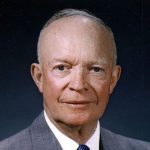 We don’t often think of generals feeling anguish over men lost in the battles they are sent to fight. It’s not that we don’t realize that they feel bad for sending these men into battle, to their possible deaths, even to their probable deaths, because we do. Still, they are the generals, and far above the rank and file…the little guys. Generals, Admirals, the President…could they even realize the consequences of their decisions in the lives of the people under them? I think most of us somehow think that the generals and even the president have no idea how many people they are condemning to death by the orders they give. In reality, nothing could be further from the truth.
We don’t often think of generals feeling anguish over men lost in the battles they are sent to fight. It’s not that we don’t realize that they feel bad for sending these men into battle, to their possible deaths, even to their probable deaths, because we do. Still, they are the generals, and far above the rank and file…the little guys. Generals, Admirals, the President…could they even realize the consequences of their decisions in the lives of the people under them? I think most of us somehow think that the generals and even the president have no idea how many people they are condemning to death by the orders they give. In reality, nothing could be further from the truth.
General Eisenhower, known as “Ike” was the one with the final say in the D-Day attack that could potentially take the lives of more than 160,000 men, as well as the possible destruction of nearly 12,000 aircraft, almost 7,000 sea vessels. The attack was supposed to take place on June 5, 1944, but the weather was not cooperative. For the attack to work, several factors had to be optimally in favor of the Allies. Nevertheless, these were factors that could not be controlled by humans. Things like the tides, the moon, and the weather. They needed low tide and bright lunar conditions, limiting the possibilities to just a few days each month. The dates for June 1944 were the fifth, the sixth, and the seventh. It was a very small window, and then the weather on the fifth didn’t cooperate either. If the attack was not launched on one 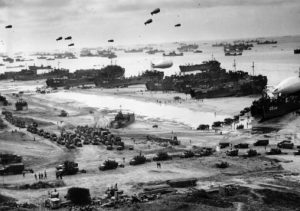 of those dates, Ike would be forced to wait until June 19 to try again. Not only did that mean more deaths because of the German occupation, but keeping the attack secret was harder, the longer they had to wait.
of those dates, Ike would be forced to wait until June 19 to try again. Not only did that mean more deaths because of the German occupation, but keeping the attack secret was harder, the longer they had to wait.
Finally, it looked like June 6, 1944 was going to cooperate. All of his advisors told him that their part was a go. Finally it was time for the final decision…one that belonged only to Eisenhower. He labored over the decision. It was not one where he could decide from his lofty position and never think about it again. He knew that he was sending men to their deaths…to certain death. He couldn’t pass the buck. He couldn’t call a dozen people to see how they felt about it. He had to decide. And so he did. History has argued what his exact words were, some said, “Ok, let ‘er rip.” or “Well, we’ll go” or “All right, we move” or “OK, boys, We will go.” or “We will attack tomorrow.” I don’t suppose it really matters what he said exactly, but rather, it mattered what happened after. We now know that the Allied casualties on June 6 have been estimated at 10,000 killed, wounded, and missing in action. Among those were 6,603 Americans, 2,700 British, and 946 Canadians. It ended with an Allied victory, but it was not without cost…the loss of lives was great. Eisenhower could not “celebrate” the anniversary of D-Day, thinking that it would be like patting himself on the back, but I think that the biggest 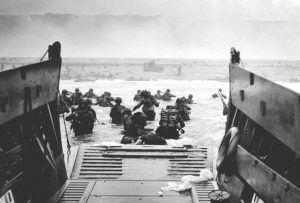 picture of the weight that the attack placed on Eisenhower was when he was going to a reunion with the 82nd Airborne Division. Upon seeing him, the men stood, cheering and whistling. Reporter Val Lauder had spoken to him, and later watched the news broadcast of the reunion, when her mother noticed something odd. Says Lauder, “My mother, watching with me, said, ‘He’s crying. Why is he crying?’ I said, ‘He’s looking out at a roomful of men he once thought he could be sending to their death.'” That says it all. Ike didn’t just pull the plug and send those men to their deaths…never giving it another thought. The decision haunted him for years, and quite likely the rest of his life.
picture of the weight that the attack placed on Eisenhower was when he was going to a reunion with the 82nd Airborne Division. Upon seeing him, the men stood, cheering and whistling. Reporter Val Lauder had spoken to him, and later watched the news broadcast of the reunion, when her mother noticed something odd. Says Lauder, “My mother, watching with me, said, ‘He’s crying. Why is he crying?’ I said, ‘He’s looking out at a roomful of men he once thought he could be sending to their death.'” That says it all. Ike didn’t just pull the plug and send those men to their deaths…never giving it another thought. The decision haunted him for years, and quite likely the rest of his life.
 Recently, while listening to an Audible book that was read by the author, from Australia, I began to wonder about his accent, or rather how accents were developed. He had a traditional Australian accent, but I knew from history that Australia was originally part of England, in fact it was their prison island. So, why didn’t the Australians speak with an English accent? I suppose that they did, originally, but after years of living far away from their homeland, the language evolved. Languages tend to do that, even today. people come up with new slang words, and say words in funny ways, then after a while it just sounds better to them the new way. Some people, like the prisoners, might not want to sound anything like the country they came from. For that reason, or for any reason that you would work at gaining or losing as accent, the person tries not to sound like they did with their old accent, working toward their new accent, until it feels natural. Then, the children learn to speak by listening to their parents, and a new accent is born.
Recently, while listening to an Audible book that was read by the author, from Australia, I began to wonder about his accent, or rather how accents were developed. He had a traditional Australian accent, but I knew from history that Australia was originally part of England, in fact it was their prison island. So, why didn’t the Australians speak with an English accent? I suppose that they did, originally, but after years of living far away from their homeland, the language evolved. Languages tend to do that, even today. people come up with new slang words, and say words in funny ways, then after a while it just sounds better to them the new way. Some people, like the prisoners, might not want to sound anything like the country they came from. For that reason, or for any reason that you would work at gaining or losing as accent, the person tries not to sound like they did with their old accent, working toward their new accent, until it feels natural. Then, the children learn to speak by listening to their parents, and a new accent is born.

As a child, I moved from my birthplace in Superior, Wisconsin, where my Uncle Bill’s family lived, to Casper, Wyoming, where my mom’s family lived. As the years went by, unbeknownst to us, my sister, Cheryl and I began to lose our accent. I didn’t even know we had an accent. Of course, when the change was pointed out to us, that we had an accent, we were shocked. We thought our Wisconsin cousins had an accent. Of course, we both did. Theirs was a Midwestern accent, and ours was a Western accent. It’s really strange to consider that the United States has basically four, and maybe five different accents. Somehow, I didn’t think of my own accent as being an accent, until my cousin mentioned it. I think we all recognize a Southern accent, but some of the others are a little bit more subtle, except maybe the Eastern accent. When about sounds like aboot, and Boston sounds like Baston, it isn’t something that is easily missed. It stands out as much as the Southern y’all 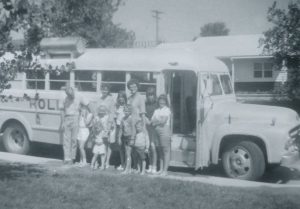 that we are all so fond of.
that we are all so fond of.
Language is ever evolving. We have created new words for things we didn’t have before, or slang words for things we have always had. We have made up words just to be funny, and somehow they new words stuck, and even got added to the dictionary at some point. Words that were unacceptable grammar in times past, suddenly are acceptable. The way we talk compared to the way of just one or two generations ago, can be enough different that if we saw them side by side, we would almost never know that the two dialects started out as one.
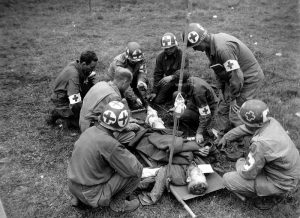 Wearing a white armband with the red cross signifying that a soldier is a medic, did not guarantee their safety in combat. Bombs raining down from the sky could not distinguish the target as a medic when they fell, nor could bullets shot from the guns of the enemy. Nevertheless, they ran into the line of fire at the cry of, “Medic!!” Of course, they were scared. They knew that, at that moment, their life expectancy was about one minute. They had to dodge the bullets and bombs just to do their job. Most of us can’t imagine the fear they must have felt. Still, in that moment, they were the only thing standing between the wounded soldiers and certain death. Soldiers were stunned to see a medic running through the machine gun fire just to put a tourniquet on the battered arm of the wounded soldier. The medic risked his own life to save the lives of others.
Wearing a white armband with the red cross signifying that a soldier is a medic, did not guarantee their safety in combat. Bombs raining down from the sky could not distinguish the target as a medic when they fell, nor could bullets shot from the guns of the enemy. Nevertheless, they ran into the line of fire at the cry of, “Medic!!” Of course, they were scared. They knew that, at that moment, their life expectancy was about one minute. They had to dodge the bullets and bombs just to do their job. Most of us can’t imagine the fear they must have felt. Still, in that moment, they were the only thing standing between the wounded soldiers and certain death. Soldiers were stunned to see a medic running through the machine gun fire just to put a tourniquet on the battered arm of the wounded soldier. The medic risked his own life to save the lives of others.
The medics received the same combat training as the other infantrymen, but they didn’t carry a weapon. Imagine finding yourself in the middle of a war zone and all you have with you is a first aid kit. The idea, I’m sure, is that the soldiers will protect the medics, but can they really. The soldiers are fighting for their own lives. It’s not that they don’t want to protect the medics or their fellow soldiers, but rather that they can’t. They are too busy fighting off the enemy.
Often the men who went in as medics were volunteer conscientious objectors. I don’t know if they realized that a conscientious objector didn’t get out of the war, but rather just didn’t get a gun…for shooting or for protection. Something like that would make me reconsider conscientious objection. I’m not one that wants to kill people, but self defense is another thing entirely. When medics went through their training, the other soldiers were rather negative toward them, often calling them “pill pushers,” but all their disdain disappeared when they saw the medics in action on the battlefield. The medics were right there beside the soldiers in the 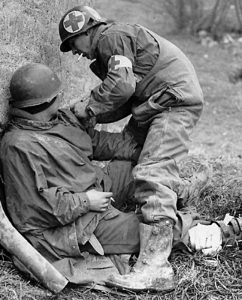 foxholes. They were with them as they advanced during offensives. Then, while the fighting raged, they went between lines attending to the wounded. They disregarded the danger to themselves, and did their duty. The tools of their trade were limited. Often their examination would be followed with a tourniquet and a morphine injection, before cleaning the wound and sprinkling sulfa powder on it. Then they bandaged the wound and dragged the wounded soldier off the field…all in a matter of minutes or less.
foxholes. They were with them as they advanced during offensives. Then, while the fighting raged, they went between lines attending to the wounded. They disregarded the danger to themselves, and did their duty. The tools of their trade were limited. Often their examination would be followed with a tourniquet and a morphine injection, before cleaning the wound and sprinkling sulfa powder on it. Then they bandaged the wound and dragged the wounded soldier off the field…all in a matter of minutes or less.
Medics were protected by the Geneva Convention, but the Red Cross that was displayed on their helmet, was a practice that was abandoned during the Vietnam War. Believe it or not, the cross on the helmet became a target for the enemy. By then, medics also had weapons…just for protection, but my guess is that they were probably glad they had it, but not so in World War II. Armed or not, many were severely injured or killed while attending to the wounded, and that made them a unique kind of hero.
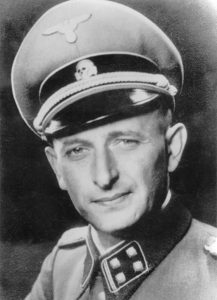 As World War II was winding down, and it was becoming abundantly clear that Nazi Germany was not going to win, the “brave” leaders of the Third Reich began to make plans to run out on their Army, leaving them to take the fall alone. The Nazi leaders were given aliases, and plans were made to get them to Argentina, a country known for its lax immigration policies. The Nazis planned to regroup in Argentina and try for world domination again at a later date.
As World War II was winding down, and it was becoming abundantly clear that Nazi Germany was not going to win, the “brave” leaders of the Third Reich began to make plans to run out on their Army, leaving them to take the fall alone. The Nazi leaders were given aliases, and plans were made to get them to Argentina, a country known for its lax immigration policies. The Nazis planned to regroup in Argentina and try for world domination again at a later date.
Hitler’s hatred for Jews, like any racism was not logical. The Jewish people had done nothing to Hitler or any other German person. This was just a sick personal idea of Hitler’s. It comes from an intolerance to the differences that are naturally occurring in humans, and why would we want to all look the same anyway. It makes no sense at all. Different people have different things to contribute to any society, but Hitler could only see his own twisted idea of a perfect person…odd, when you consider the fact that Hitler would not have fit into his own mold of “perfect” at all. Hitler had a number of conditions that would have, by his own standards, have precipitated his death by the very people who enforced Hitler’s laws.
The man Hitler put in charge of his “final solution of the Jewish question,” Adolf Eichmann, was a man who’s racism and evil personality were quite likely equal to Hitler’s. I have no idea how anyone could plan the murder  of millions of people, of any race, without that person being evil itself. Eichmann was just that. He knew what he was doing, and he relished the idea of “being a god” over those people’s lives…choosing who lives and who dies. Most of us dislike jury duty, because we don’t want to make such decisions for fellow citizens, but Eichmann loved it…thrived on it.
of millions of people, of any race, without that person being evil itself. Eichmann was just that. He knew what he was doing, and he relished the idea of “being a god” over those people’s lives…choosing who lives and who dies. Most of us dislike jury duty, because we don’t want to make such decisions for fellow citizens, but Eichmann loved it…thrived on it.
Eichmann was born in Solingen, Germany, in 1906. Eichmann joined the Nazi’s elite SS (Schutzstaffel) organization in November 1932. The members of the SS came to have broad responsibilities in Nazi Germany, including policing, intelligence, and the enforcement of Adolf Hitler’s anti-Semitic policies. Eichmann was good at his job, and steadily rose in the SS hierarchy. When the Nazis annexed Austria in 1938, Eichmann was sent to Vienna, His mission…rid the city of Jews. He set up an efficient Jewish deportment center and in 1939 was sent to Prague on a similar mission. That year, Eichmann was appointed to the Jewish section of the SS central security office in Berlin. I don’t know how he could have looked himself in the mirror.
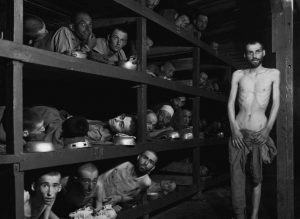 After the war, Eichmann was captured by US troops. Somehow, he managed to escape from the prison camp in 1946, before the Nuremberg International War Crimes Tribunal. Taking an assumed identity, Eichmann traveled between Europe and the Middle East. Finally, in 1950 Eichmann arrived in Argentina. In 1957, a German prosecutor secretly informed Israel that Eichmann was living in Argentina. Time had not forgiven the crimes Eichmann had committed. Agents from the Mossad, Israel’s intelligence service, were deployed to Argentina, and in early 1960 they finally located Eichmann. He was living in the San Fernando section of Buenos Aires under the name of Ricardo Klement. He was taken back to Israel, and on May 31, 1962, he was finally hanged for his horrific crimes against humanity.
After the war, Eichmann was captured by US troops. Somehow, he managed to escape from the prison camp in 1946, before the Nuremberg International War Crimes Tribunal. Taking an assumed identity, Eichmann traveled between Europe and the Middle East. Finally, in 1950 Eichmann arrived in Argentina. In 1957, a German prosecutor secretly informed Israel that Eichmann was living in Argentina. Time had not forgiven the crimes Eichmann had committed. Agents from the Mossad, Israel’s intelligence service, were deployed to Argentina, and in early 1960 they finally located Eichmann. He was living in the San Fernando section of Buenos Aires under the name of Ricardo Klement. He was taken back to Israel, and on May 31, 1962, he was finally hanged for his horrific crimes against humanity.
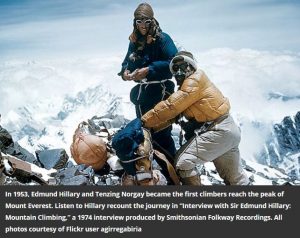 The news of June 2, 1953 was of Queen Elizabeth II’s coronation, but also of the hailed “good omen” for their country’s future…in reference to the first explorers to reach the summit of Mount Everest, which at 29,035 feet above sea level is the highest point on earth. The landmark assent to the top of the world culminated at 11:30am on May 29, 1953 when Edmund Hillary of New Zealand and Tenzing Norgay, a Sherpa of Nepal, made their final assault on the summit after spending a fitful night at 27,900 feet.
The news of June 2, 1953 was of Queen Elizabeth II’s coronation, but also of the hailed “good omen” for their country’s future…in reference to the first explorers to reach the summit of Mount Everest, which at 29,035 feet above sea level is the highest point on earth. The landmark assent to the top of the world culminated at 11:30am on May 29, 1953 when Edmund Hillary of New Zealand and Tenzing Norgay, a Sherpa of Nepal, made their final assault on the summit after spending a fitful night at 27,900 feet.
While the first summit of Mount Everest was an epic accomplishment, it was the words “fitful night” that drew my attention the most. I recently finished a novel by Harry Farthing called “Summit.” While his book was a novel, much of it was based on, if not actual events, actual conditions on the mountain. I am a hiker, and I like hiking to the highest mountains in an area, but let it be known that I am not a mountain climber, and I have no desire to hike through treacherous snow storms to reach the victory of the summit. Nevertheless, many people are obsessed with getting to the world’s highest peaks. Such was the case with Hillary and Norgay. They were determined to make it. I have no idea how prepared they were, but since their victory, and quite possibly before it too, there have been those who misjudged the mountain, the storms, and their own abilities…to their detriment.
While listening to “Summit,” I found myself cheering on the climbers, but also feeling the depths of the many defeats along the way. The biggest necessity on the mountain, is oxygen. At the base camp of Mount Everest, which is 17,500 feet, the air contains 50% of oxygen levels at sea level. At that level, without oxygen, people feel tired and light-headed and develop a headache. They might feel nauseous and even begin to vomit up everything they eat, and then just dry heave themselves to exhaustion. Of course, having oxygen tanks can change this situation into one that is manageable for survival. And that is just at the base camp, which is almost 12,000 feet below the summit. Between Camp 1, at 20,000 feet, and Camp 3, at 24,000 the oxygen levels drop to below 40%. At this point you are prone to hallucinate. Your whole body hurts. You can’t eat, sleep, and most people find breathing next to impossible. From here you operate on sheer willpower. You put one foot in front of the other, and keep moving, because if you do not, you will die. As you near the summit, at 29,035 feet, the air has less that one-third of the sea level oxygen, and can drop as low as 14%…a low level that was recorded in 1996. Twenty climbers lost their fight with the mountain, and their lives, that year. At this point, you should for all intents and purposes be dead. If you are still going, you are probably one of just a few people. On May 8, 1978, Reinhold Messner and Peter Habeler reached the summit of Mount Everest. They were the first men known to climb it without the use of supplemental oxygen. Two years later, on August 20, 1980, Messner again stood atop the highest mountain in the world, without supplementary oxygen. Cory Richards and Adrian Ballinger also summited the highest mountain in the world in 2017…Ballinger without supplemental oxygen. I don’t know how they did it. Those who have failed to make it to the summit, with or without oxygen, have said that they now know what dying feels like. I’m sure that doesn’t apply to all kinds of death, but certainly death on Mount Everest or any of the other mountains that are nearly as tall, it is like this. The symptoms of death by oxygen depravation quickly take their toll on the body. In the minutes before death, the pain must be excruciating. And then, still before death arrives, the body gives up, and feels no more. The  people that die on Everest are left on Everest. They climbers that go up, pass them along the way. It is a grim reminder that if you are not prepared, you might not be coming down.
people that die on Everest are left on Everest. They climbers that go up, pass them along the way. It is a grim reminder that if you are not prepared, you might not be coming down.
Mount Everest sits on the crest of the Great Himalayas in Asia, lying on the border between Nepal and Tibet. Called Chomo-Lungma, or “Mother Goddess of the Land,” by the Tibetans, the English named the mountain after Sir George Everest, a 19th-century British surveyor of South Asia. It is a majestic mountain, and one I might enjoy seeing…from an airplane…but it is not one that I would ever choose to climb, even though I love to hike. Nevertheless, you can’t help be to be in awe of those who would climb the mountain and receive that treacherous victory.
 Every security detail prides itself in being able to stop any attack that might come toward the person or persons they are assigned to protect. Allowing a threat, any threat…be it a serious threat, or a minor prank…to get by the security check points, is seriously embarrassing and can be very dangerous. Never was this more widely publicized than on May 28, 1987, in Moscow.
Every security detail prides itself in being able to stop any attack that might come toward the person or persons they are assigned to protect. Allowing a threat, any threat…be it a serious threat, or a minor prank…to get by the security check points, is seriously embarrassing and can be very dangerous. Never was this more widely publicized than on May 28, 1987, in Moscow.
Early on that morning, a young man named Matthias Rust, a 19 year old amateur pilot from West Germany, took off from Helsinki, Finland and headed east. Rust flew his small Cessna airplane through 400 miles of Soviet airspace, somehow undetected, and landed it in Red Square by the Kremlin. The stunt was an immense embarrassment to the Soviet government and military…to say the least. I would think that “heads would roll” figuratively speaking. Red Square should be some of the most seriously protected airspace in the world, but here a 19 year old kid blew through the protections they had in place, and brazenly landed his small plane right in the middle of Red Square!!
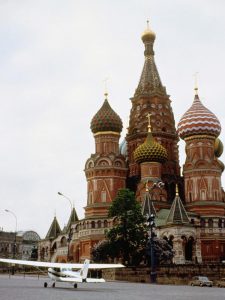
Rust was not a known troublemaker. His mother said that he was a “quiet young man with a passion for flying.” He had no known political or social agenda when he took off from the international airport in Helsinki and headed for Moscow, so what was the purpose of his flight and subsequent illegal landing. He entered Soviet airspace, but was either undetected or ignored as he pushed farther and farther into the Soviet Union, but how was that possible. He arrived over Moscow, early that morning, circled Red Square a few times, and then simply landed…just a few hundred yards from the Kremlin. The people in the square, mostly curious onlookers and tourists, believed that Rust was part of an air show. They quickly surrounded him, probably wanting his autograph. Then, very quickly, Rust was arrested and taken to jail. The charges were severe. He was tried for violating Soviet airspace and sentenced to prison. I don’t know if the charge would have normally gained him a longer prison sentence, or if they took pity on him because of his age, but Rust served 18 months before being released…probably a relatively short sentence in retrospect.
The repercussions in the Soviet Union, however, were immediate. Soviet leader Mikhail Gorbachev fired his minister of defense, and the entire Russian military was humiliated by Rust’s flight into Moscow. The United  States officials didn’t make matters any easier either. They had a field day with the event. One American diplomat in the Soviet Union joked, “Maybe we should build a bunch of Cessnas.” The Soviet officials were not amused. Just four years earlier, the Soviets had been harshly criticized for shooting down a Korean Airlines passenger jet that veered into Russian airspace. Now, being able to stop one teenager’s “invasion” of the country, the Soviets became the laughingstocks. One Russian spokesperson bluntly declared, “You criticize us for shooting down a plane, and now you criticize us for not shooting down a plane.” No matter how you look at it, the situation was, to say the least, militarily embarrassing.
States officials didn’t make matters any easier either. They had a field day with the event. One American diplomat in the Soviet Union joked, “Maybe we should build a bunch of Cessnas.” The Soviet officials were not amused. Just four years earlier, the Soviets had been harshly criticized for shooting down a Korean Airlines passenger jet that veered into Russian airspace. Now, being able to stop one teenager’s “invasion” of the country, the Soviets became the laughingstocks. One Russian spokesperson bluntly declared, “You criticize us for shooting down a plane, and now you criticize us for not shooting down a plane.” No matter how you look at it, the situation was, to say the least, militarily embarrassing.
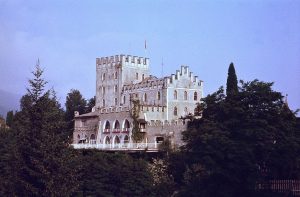 World War II was one time when the United States and Germany were absolutely not friends. The Nazi beliefs and the American beliefs were worlds apart. Nevertheless, not all Germans were Nazis, and hard to believe as that may be, it was true. Never was that more evident that at Castle Itter, a small fortification in Austria used by the SS during World War II as a prison for high profile detainees. On May 6, 1945, with the Third Reich collapsing against the Allied attacks, the German commander of Dachau, Wilhelm Weiter committed suicide. At that point, some of the Waffen SS soldiers retreated, and amid the chaos that followed, the opportunity presented itself, and a Yugoslav freedom fighter, Zvonimir Cuckovic, who was a prisoner at Dachau, escaped and went looking for some Allied troops to rescue the rest of the prisoners.
World War II was one time when the United States and Germany were absolutely not friends. The Nazi beliefs and the American beliefs were worlds apart. Nevertheless, not all Germans were Nazis, and hard to believe as that may be, it was true. Never was that more evident that at Castle Itter, a small fortification in Austria used by the SS during World War II as a prison for high profile detainees. On May 6, 1945, with the Third Reich collapsing against the Allied attacks, the German commander of Dachau, Wilhelm Weiter committed suicide. At that point, some of the Waffen SS soldiers retreated, and amid the chaos that followed, the opportunity presented itself, and a Yugoslav freedom fighter, Zvonimir Cuckovic, who was a prisoner at Dachau, escaped and went looking for some Allied troops to rescue the rest of the prisoners.
Hans Fuchs, who was a young student going to school nearby, remembers how Itter Castle was converted into a prison by the Nazis in 1943. He said, “We saw everything from our school window, a double barbed-wire fence…and floodlights so that the whole night was lit up like day.” Itter Castle, is an old castle, dating back to the Middle Ages. It was turned into a sub-unit of the Dachau concentration camp, and used for VIP prisoners, prominent politicians, and military figures that the Nazis wanted to use as bargaining chips. Famous prisoners 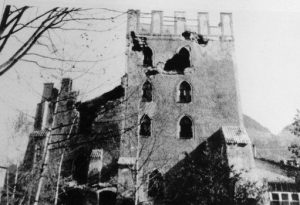 there included two former prime ministers of France, Edouard Daladier and Paul Reynaud, as well as the elder sister of Gen Charles de Gaulle, Marie-Agnes Cailliau.
there included two former prime ministers of France, Edouard Daladier and Paul Reynaud, as well as the elder sister of Gen Charles de Gaulle, Marie-Agnes Cailliau.
Cuckovic’s escape triggered one of the most curious battles of the conflict, but not in the way you might think. After he escaped, Cuckovic found an American armored column and got them to come with him. At the same time a Major Josef Gangl, who was an Austrian in the German Army, and had been collaborating with Austrian resistance in the closing days of the war, also intended to free the castle prisoners, but had decided instead to surrender with his men to the Americans. Gangl hated what was going on and knew that the Nazis were friends to no one. He could no longer stomach what he had been commanded to do. With the arrival of Cuckovic a hasty agreement took place. The major and his Wehrmacht troops would fight alongside the Americans against the SS guards.
The resulting battle of Castle Itter was not a major battle, just an amazing one. The SS faced not only their own countrymen and Americans, complete with a Sherman tank, but there were also Austrian partisans and French prisoners joining in. It was a wonderful show of the unifying effect the Allies had compared to the polarizing effect of the Nazis. The ensuing battle was not big, and in fact, a maximum of just 100 men were  involved. Nevertheless, this battle was, without a doubt, vicious. The Sherman tank was destroyed and Major Josef Gangl was killed by a sniper. The thing that made this battle so unique, however, was that it was the only time the American army fought alongside the German army in all of World War II. The SS were handily defeated and quickly surrendered. The rest of the prisoners held at Castle Itter were released unharmed.
involved. Nevertheless, this battle was, without a doubt, vicious. The Sherman tank was destroyed and Major Josef Gangl was killed by a sniper. The thing that made this battle so unique, however, was that it was the only time the American army fought alongside the German army in all of World War II. The SS were handily defeated and quickly surrendered. The rest of the prisoners held at Castle Itter were released unharmed.
There have been times in many wars, when two soldiers made the conscious decision not to engage in battle, allowing both to live to fight another day. I suppose it would not be unheard of to have two opposing soldiers work together to defeat a common enemy, like maybe a bear or other wild animal, but for two army patrols of two opposing sides, to join forces against part of one sides army, is…well, unheard of. The battle at Castle Itter was just such a battle, and it is believed to be the only battle in the war in which Americans and Germans fought as allies.
 As New York City grew is size, passing Paris in population and quickly catching up to London by the late 19th century too, it still remained the only city of such size to lack a public library large enough to serve it’s many citizens. It didn’t look like something that was going to change in the near future, but when former New York Governor Samuel J. Tilden died in 1886, he left $2.4 million to the city to “establish and maintain a free library and reading room in the city of New York.”
As New York City grew is size, passing Paris in population and quickly catching up to London by the late 19th century too, it still remained the only city of such size to lack a public library large enough to serve it’s many citizens. It didn’t look like something that was going to change in the near future, but when former New York Governor Samuel J. Tilden died in 1886, he left $2.4 million to the city to “establish and maintain a free library and reading room in the city of New York.”
While it was a wonderful gift, it remain unspent until May 23, 1895, when New York’s two largest libraries…the Astor and Lenox libraries…agreed to combine with the Tilden Trust to form a new entity that would be known as The New York Public Library. I’m not sure why the delay, other than maybe the loss of some of the smaller 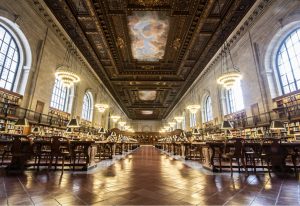 “neighborhood” libraries. Whatever the case may be, the work finally began on the New York Public Library, and the final structure was spectacular.
“neighborhood” libraries. Whatever the case may be, the work finally began on the New York Public Library, and the final structure was spectacular.
The main branch of the library was dedicated in midtown Manhattan sixteen years later to the day. The library is the largest marble structure ever constructed in the United States, is dedicated in New York City. I don’t know much about construction, but it seems to me that marble construction might be harder. The building fills a two-block section of Fifth Avenue between 40th and 42nd Streets, the monumental structure took 14 years to complete at a cost of $9 million. Nevertheless, the day after its dedication, the library opened its doors to the public, and some 40,000 citizens passed through to make use of a collection that already consisted of more than a million books. The people of New York City were excited to have such a wonderful collection of 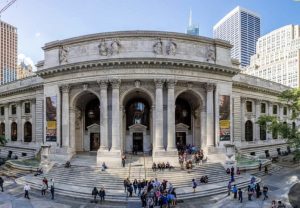 knowledge at their disposal…and for free. In a ceremony presided over by President William Howard Taft, the New York Public Library was dedicated on May 23, 1911. Gifts continues to roll in over the next few decades, and thanks in large part to a $5.2 million gift from steel baron Andrew Carnegie, a system of branch libraries opened throughout New York City, basically giving back some of the neighborhood library feel again. Today, the New York Public Library is visited and used annually by more than 10 million people, and there are currently well over two million cardholders, more than for any other library system in the nation.
knowledge at their disposal…and for free. In a ceremony presided over by President William Howard Taft, the New York Public Library was dedicated on May 23, 1911. Gifts continues to roll in over the next few decades, and thanks in large part to a $5.2 million gift from steel baron Andrew Carnegie, a system of branch libraries opened throughout New York City, basically giving back some of the neighborhood library feel again. Today, the New York Public Library is visited and used annually by more than 10 million people, and there are currently well over two million cardholders, more than for any other library system in the nation.
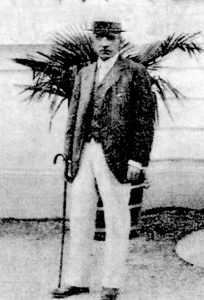 I’m not a superstitious person…don’t believe in that sort of thing, but I can a strange coincidence as clearly as the next guy. Ramon Artagaveytia was born July 14, 1840 in Montevideo, Uruguay, to Ramon and Maria Artagaveytia. December 24, 1871 found Artagaveytia sailing on the America, a ship out of Uruguay, when the boiler overheated and caught fire. The resulting catastrophic damage doomed the America to the ocean floor. Witnesses said that the America had been racing another ship into the port at Montevideo Harbor at a high rate of speed, and it is thought that the excessive boiler pressure caused it to catch fire.
I’m not a superstitious person…don’t believe in that sort of thing, but I can a strange coincidence as clearly as the next guy. Ramon Artagaveytia was born July 14, 1840 in Montevideo, Uruguay, to Ramon and Maria Artagaveytia. December 24, 1871 found Artagaveytia sailing on the America, a ship out of Uruguay, when the boiler overheated and caught fire. The resulting catastrophic damage doomed the America to the ocean floor. Witnesses said that the America had been racing another ship into the port at Montevideo Harbor at a high rate of speed, and it is thought that the excessive boiler pressure caused it to catch fire.
At the time of her sinking, America was carrying 114 first class, 29 second class, and 30 “popular” class passengers. I’m not sure what “popular” class, was, but I assume steerage. Of the 173 passengers, only 65 survived the sinking. Artagaveytia probably would not have been one of them, but he made a last ditch effort and jumped overboard and swam for his life. He recalled later that so many of the passengers were badly burned, and the ensuing nightmares Artagaveytia suffered, kept him too terrified to travel by ship for the next 40 years. That was particularly hard for Artagaveytia, who came from a family of sailors.
In 1905, Artagaveytia took over a farm in Garamini, Argentina. In 1912, Artagaveytia was still living in Argentina, but decided visit his nephew, who was the head of the Uruguayan Consulate in Berlin. Before returning home to Argentina, he decided to visit the United States, and it was that decision that sealed his fate. Artagaveytia told his cousin that he finally felt at ease about traveling on a ship. He thought he might even be able to sleep while on board, and not stand always at the rail wearing his life jacket. The thing that finally made him feel better about travel by ships was the wireless telegraph. He finally thought that someone would know  where these ships were, and that they could arrive quickly to help if needed. With that knowledge and the peace of mind it brought with it, Artagaveytia boarded the Titanic. Everyone knows the fate of the Titanic, and how so many mistakes were made…from sailing too fast, to ignoring the warnings, to turning off that all important radio. Ramon Artagaveytia had survived the sinking of the steamer America, but he would not make such an escape from Titanic. About a week after the disaster, his body was pulled from the North Atlantic. Once they were sure of his identity, he was returned to the Uruguayan Consul at Halifax. His body was forwarded to New York and then to Montevideo, Uruguay. He was buried in Cemeterio Central in Montevideo on June 18, 1912.
where these ships were, and that they could arrive quickly to help if needed. With that knowledge and the peace of mind it brought with it, Artagaveytia boarded the Titanic. Everyone knows the fate of the Titanic, and how so many mistakes were made…from sailing too fast, to ignoring the warnings, to turning off that all important radio. Ramon Artagaveytia had survived the sinking of the steamer America, but he would not make such an escape from Titanic. About a week after the disaster, his body was pulled from the North Atlantic. Once they were sure of his identity, he was returned to the Uruguayan Consul at Halifax. His body was forwarded to New York and then to Montevideo, Uruguay. He was buried in Cemeterio Central in Montevideo on June 18, 1912.
 Following his marriage to a wealthy widow named Virginia Mason, Wilmer McLean moved onto her small plantation in Manassas Junction, Virginia. The property was beautiful, and a small stream called Bull Run ran through it. Fourteen slaves tended the fields of Yorkshire, named for the home county of English native Richard Blackburn who had established the plantation in the early 1700s. Little did Wilmer know at the time of his marriage, that in a mere eight years, their plantation would be the center of the beginning of the American Civil War.
Following his marriage to a wealthy widow named Virginia Mason, Wilmer McLean moved onto her small plantation in Manassas Junction, Virginia. The property was beautiful, and a small stream called Bull Run ran through it. Fourteen slaves tended the fields of Yorkshire, named for the home county of English native Richard Blackburn who had established the plantation in the early 1700s. Little did Wilmer know at the time of his marriage, that in a mere eight years, their plantation would be the center of the beginning of the American Civil War.
When the Civil War broke out in 1861, McLean was too old to serve on the Confederate Army, but that did not prevent his involvement in the war. When I think of the Civil War, I somehow think of two armies coming together out in the middle of nowhere in an open field. Of course, war isn’t that simple. War takes place in towns and villages and city streets too. When the two armies, the Union and the Confederates came to the place of their first battle, it would just happen to be ight in the middle of McLean’s plantation. The battle, the first major engagement between Union and Confederate forces, taking place in July 1861, would be remembered as the First Battle of Bull Run…fought right there at the stream on the McLean plantation.
As Union forces approached on a 30-mile march west from Washington DC, Confederate General P.G.T. Beauregard took over the Yorkshire Plantation farmhouse in Manassas as his headquarters. Soon, McLean took his family to safer ground, and the next day, July 18, 1861, during the Battle of Blackburn’s Ford, a Union shell tore into the fireplace of McLean’s detached kitchen and ruined the dinner being prepared for Beauregard and his staff. Three days later came the Civil War’s first major encounter, the First Battle of Bull Run. The barn quickly became a makeshift military hospital, housing both wounded Confederate soldiers and captured Union fighters. The men all shared the floor of the barn, which had become, in addition to the hospital, a prisoner of war jail, as well.
Yorkshire was ravaged in the battle, and when McLean had safely tucked his family far away from the battle, he returned alone to survey the damaged plantation. I’m sure it must have been a devastation blow to McLean, but he stayed worked as an unpaid Confederate quartermaster through February 1862, before reuniting with his wife and five children in the spring.
Back at home in Yorkshire in August 1862, McLean could not believe what he was seeing when the Second Battle of Bull Run began on the Yorkshire Plantation. It seemed that he just could not outrun the war and keep his plantation too. When the Union and Confederacy clashed once again in Manassas at the Second Battle of Bull Run in August 1862, McLean began to plan on a way to better protect his family from the war. In the fall of 1863, McLean moved his family 120 miles southwest to the quiet little town of Appomattox Court House on the other side of the state of Virginia. He purchased a beautiful house, originally built as a tavern in 1848, along the Lynchburg-Richmond State Road and regularly traveled on the nearby Southside Railroad to tend to his business supplying sugar to the Confederate army.
McLean thought he had finally managed to move his family to a place where they could live in peace and quiet, but little did he know that even in Appomattox, he could not outrun the Civil War. Once again, the Civil War came calling at his door again. On April 9, 1865, Confederate Colonel Charles Marshall rode into Appomattox Court House and asked the first man he spotted, who just happened to be McLean, to help him find a suitable home to hold a meeting between the Union and Confederate commanders. McLean showed him a place, but it was a pretty dilapidated, unfurnished brick house, and Marshall quickly rejected it. Reluctantly, McLean offered his own comfortable, well furnished home…hoping that this would not be a repeat of the beginning of the war, when his home was pretty close to being destroyed.
That afternoon, in pretty much the same place it had started…the McLean parlor, history was made as Confederate General Robert E. Lee surrendered his forces to Union General Ulysses S. Grant, marking the beginning of the end of the Civil War. McLean’s homes had become a “pair of bookends” to the long four year war. Like the first meeting between McLean and the army, this one would also not end well. As General Lee departed on his horse Traveler to break the news to his troops, the Union officers launched their final raid of the war by ransacking McLean’s parlor for souvenirs of the historic meeting. According to Civil War historian, Shelby  Foote, “Something close to pandemonium set in. As McLean protested, the Union entourage walked out with the tables and chairs used by Lee and Grant, a stone inkstand, brass candlesticks and even the favorite rag doll of his 7-year-old daughter, Lula. They tore apart McLean’s cane-bottomed chairs and cut upholstery strips from his sofas as mementoes. As compensation, the soldiers shoved money into the hands of the unwilling seller and threw it onto the floor when he refused to accept it.” War is an ugly thing, and men don’t always act in a gentlemanly way to the losers, or the winners. Nevertheless, the losers are often treated far worse than the winners, as has been seen in many a war.
Foote, “Something close to pandemonium set in. As McLean protested, the Union entourage walked out with the tables and chairs used by Lee and Grant, a stone inkstand, brass candlesticks and even the favorite rag doll of his 7-year-old daughter, Lula. They tore apart McLean’s cane-bottomed chairs and cut upholstery strips from his sofas as mementoes. As compensation, the soldiers shoved money into the hands of the unwilling seller and threw it onto the floor when he refused to accept it.” War is an ugly thing, and men don’t always act in a gentlemanly way to the losers, or the winners. Nevertheless, the losers are often treated far worse than the winners, as has been seen in many a war.

